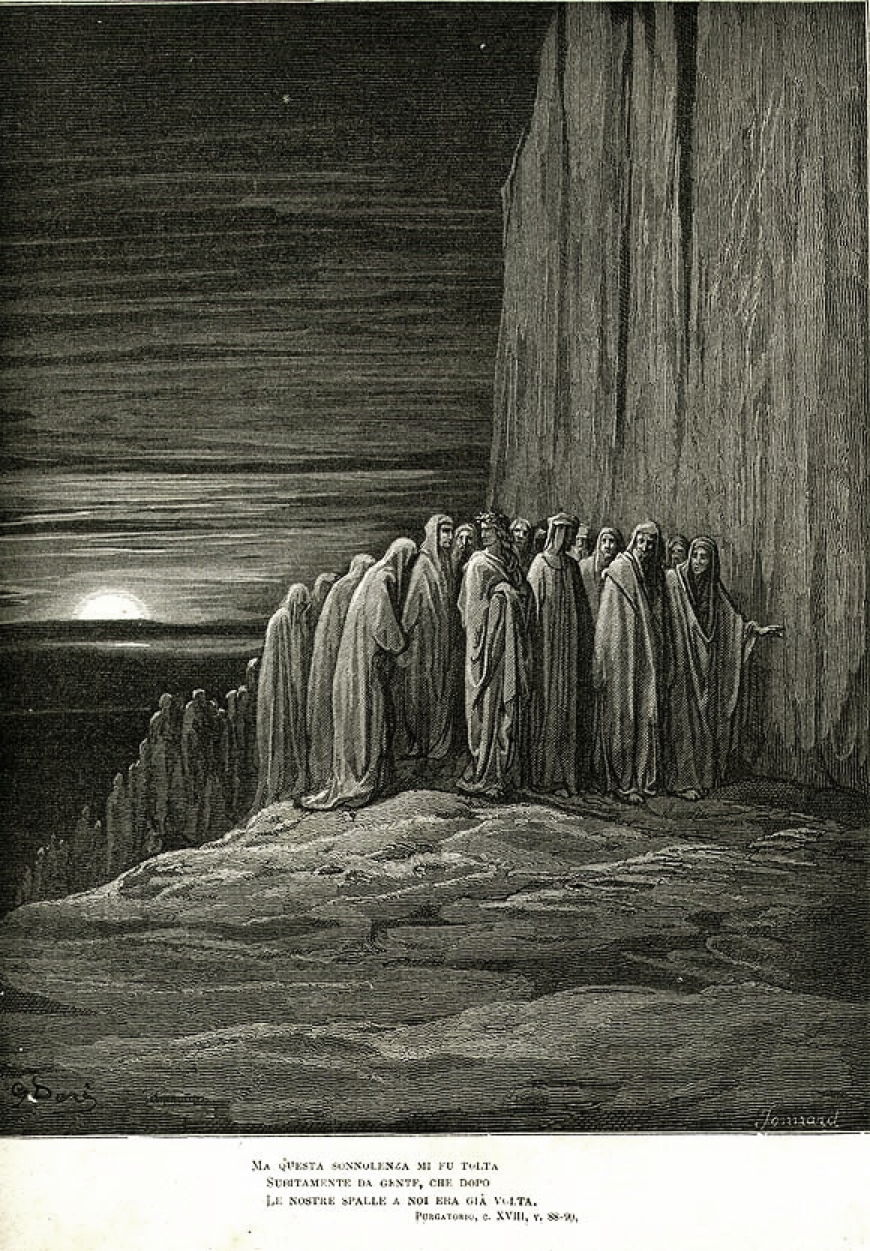Dante, guided by the spirit of Virgil, is making his way steadily up the island-mountain of Purgatory. The pair are taken up to the third terrace by one of the guardian angels, as Virgil explains to Dante how spiritual love can only grow as more share it.
On this terrace, the souls of the dead rid themselves of wrath, a process involving visions. Most prominent among the examples used is the last prayer of Saint Stephen (in French, Saint Étienne) for the forgiveness of those who cast him out of their city for preaching in the name of Jesus, and stoned him to death.



As the sun sets, its light is blocked by a rising cloud of dense smoke, forcing Dante to close his eyes. As he follows Virgil, Dante’s hand resting on the Roman’s shoulder, he converses with the worldly-wise Marco the Lombard, who blames humans for lack of virtue, most of all their leaders for their misrule.


Marco singles out Pope Boniface VIII for criticism, over his claim to both spiritual and temporal authority, which he refers to as having ‘two suns in the sky’. Dante and Virgil meet another guardian angel, who draws them up the next section of ascent just before sunset to reach the fourth terrace. Once again, the wing of that angel brushes against Dante’s brow, and removes the third P which had been inscribed there.
Through the course of the evening, Virgil explains to Dante the moral structure of Purgatory, and how the Seven Deadly Sins relate to love. Towards midnight, as Dante is dozing off, a crowd of spirits approaches them at speed, urging one another to move more quickly. They quote examples of the consequences of sloth before hurrying off.

Dante has another vivid dream that night, in which he sees a malformed woman, who transforms into a beautiful siren, one of those who had tried to lure Odysseus, before she is revealed to have foul-smelling guts. At that point he awakes, and quickly moves up the mountain with the help of another guardian angel, whose wing removes the fourth P from his forehead.

Dante and Virgil have now reached the fifth terrace, where souls rid themselves of avarice and prodigality. This is achieved by their lying face down on the hard rock while remaining immobile, and weeping. Among them is Pope Adrian V, who tells Dante how he repented of his avarice only when he had been elected to office in 1276. He then died before his investiture, just thirty-eight days later.

Dante and Virgil hear of other examples of avarice and poverty as they move around the terrace.

As they move on, the whole mountain trembles under their feet and they hear a shout of praise to God: Virgil assures Dante that he needn’t be afraid, as that is the what happens when another soul has been cleansed and moves up from Purgatory to reach its peak.
The artists
Gustave Doré (1832–1883) was the leading French illustrator of the nineteenth century, whose paintings are still relatively unknown. Early in his career, he produced a complete set of seventy illustrations for translations of the Inferno, which were first published in 1857 and continue to be used. These were followed in 1867 by more illustrations for Purgatorio and Paradiso. This article looks at his paintings.
Rembrandt Harmenszoon van Rijn (1606–1669) was one of the greatest Old Masters of all time, active first in the Dutch city of Leiden from around 1624-25, and best known for his acclaimed paintings and prints made in Amsterdam from 1631 onwards. The painting shown is one of his earliest independent works, made several years before his discovery by Constantijn Huygens. It’s believed to have been commissioned, and is one of his few showing a martyrdom.
Charles Thévenin (1764–1838) was a French neoclassical painter who won the Prix de Rome in 1791. He painted mainly contemporary history, depicting major events from the French Revolution and the days of the First Empire. Painted relatively late in his career, following his return to Paris after seven years as the Director of the French Academy in Rome, his work showing the martyrdom of Saint Stephen is unusual for its time, as such scenes had ceased being popular by the end of the seventeenth century.
References
Robin Kirkpatrick (trans) (2012) Dante, The Divine Comedy, Inferno, Purgatorio, Paradiso, Penguin Classics. ISBN 978 0 141 19749 4.
Richard Lansing (ed) (2000) The Dante Encyclopedia, Routledge. ISBN 978 0 415 87611 7.
Guy P Raffa (2009) The Complete Danteworlds, A Reader’s Guide to the Divine Comedy, Chicago UP. ISBN 978 0 2267 0270 4.
Prue Shaw (2014) Reading Dante, From Here to Eternity, Liveright. ISBN 978 1 63149 006 4.

